วารสารไทยศึกษาปีที่ 18 ฉบับที่ 1
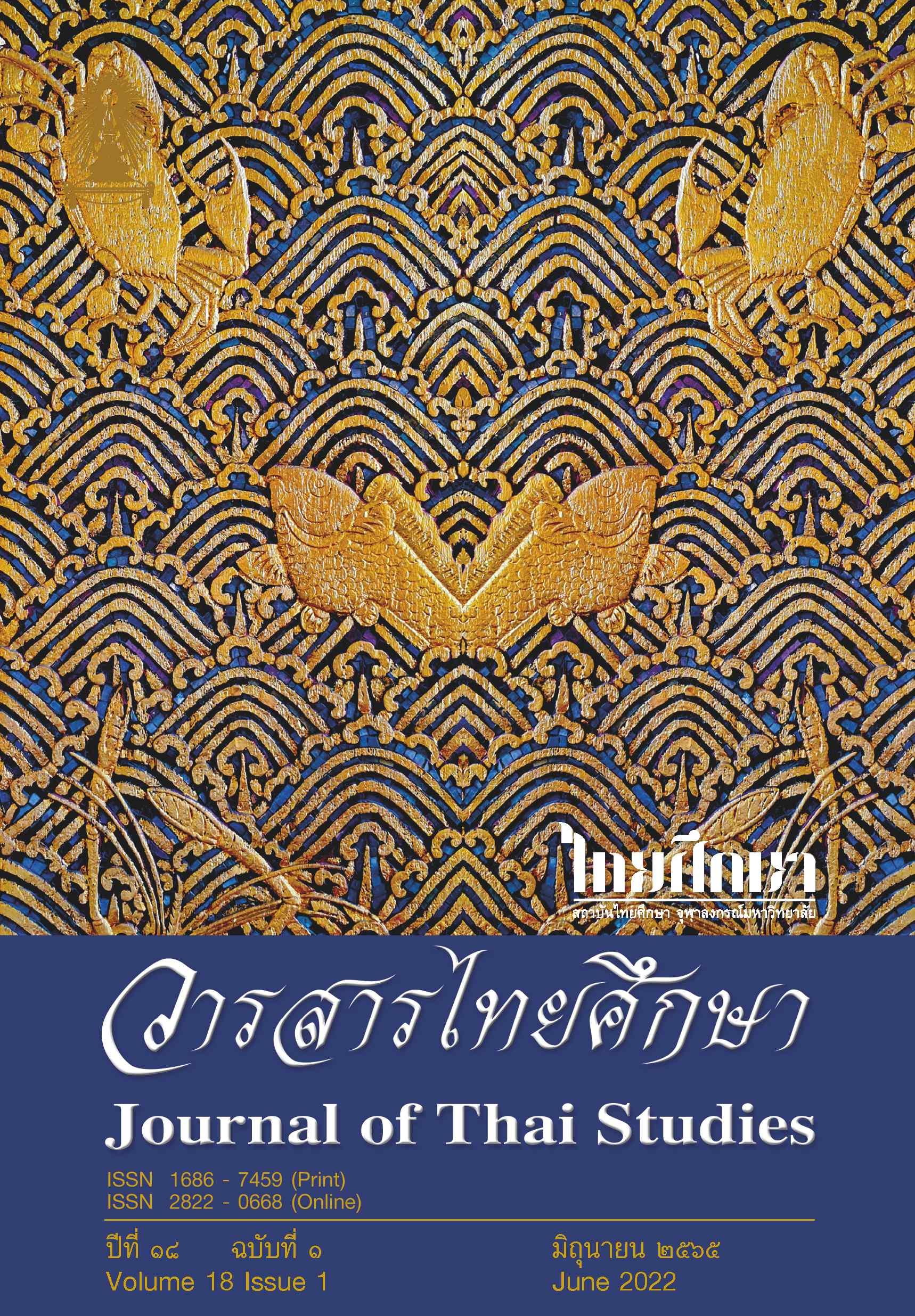
1) อุปลักษณ์เชิงมโนทัศน์ของคำเรียกสิ่งของเครื่องใช้ในภาษาไทพวน / อุษณา อารี
ณรงค์กรรณ รอดทรัพย์
2) ตำรับยากวาดคอจากตำรายาแพทย์แผนไทยของอำเภอพรหมพิราม จังหวัดพิษณุโลก / ภัครพล แสงเงิน
อุเทน วงศ์สถิตย์
3) พลวัตและวิธีคิดในการประกอบสร้างเทศกาลสงกรานต์-วันไหลในภาคตะวันออกของไทย / ชลธิชา นิสัยสัตย์ ปรมินท์ จารุวร
4) การสร้างสรรค์ละครนอกเรื่องมโนห์รา ตอน ลาสรงลงสระอโนดาต: การสืบทอดและปรับปรน / กิตติศักดิ์ เกิดอรุณสุขศรี
5) วรรณคดีไทยในหนังสืออ่านกึ่งวิชาการ (พ.ศ.๒๕๕๘-๒๕๖๒): การสร้างและเผยแพร่ความรู้
นอกหนังสือเรียนรายวิชาพื้นฐานภาษาไทยวรรณคดีวิจักษ์ (พ.ศ. ๒๕๕๑) / วรรณพร พงษ์เพ็ง
6) งานประดับมุกญี่ปุ่นในประเทศไทย:สัมพันธภาพเชิงศิลปกรรมจากเมืองท่านางาซากิ / เกรียงไกร ฮ่องเฮงเส็ง
อุปลักษณ์เชิงมโนทัศน์ของคำเรียกสิ่งของเครื่องใช้ ในภาษาไทพวน
อุปลักษณ์เชิงมโนทัศน์ของคำเรียกสิ่งของเครื่องใช้ในภาษาไทพวน
อุษณา อารี
ณรงค์กรรณ รอดทรัพย์
บทคัดย่อ
บทความนี้มีวัตถุประสงค์เพื่อศึกษาถ้อยคำอุปลักษณ์และวิเคราะห์อุปลักษณ์เชิงมโนทัศน์จากคำเรียกสิ่งของเครื่องใช้ในภาษาไทพวนตามแนวคิดทฤษฎีภาษาศาสตร์ปริชาน โดยศึกษาจากรายการสิ่งของเครื่องใช้พื้นบ้านของชาวไทพวนตำบลหาดเสี้ยวอำเภอศรีสัชนาลัย จังหวัดสุโขทัย
ผลการศึกษาพบว่ามีการขยายความหมายแบบอุปลักษณ์เชิงมโนทัศน์คิดเป็นร้อยละ ๓๕.๗๑ สามารถจัดหมวดหมู่ความหมายได้เป็น ๑๐ ประเภท เป็นการถ่ายโยงความหมายแบบภวสัมพันธ์ จำนวน ๔ ประเภท ได้แก่ อุปลักษณ์ผู้หญิงอุปลักษณ์อาการของมนุษย์ อุปลักษณ์สัตว์ และอุปลักษณ์วัตถุ (ต่างวงความหมาย) และการถ่ายโยงความหมายแบบญาณสัมพันธ์ จำนวน ๖ ประเภท ได้แก่ อุปลักษณ์วัตถุ + อาการของมนุษย์ อุปลักษณ์วัตถุ + อวัยวะของมนุษย์ อุปลักษณ์วัตถุ + สภาพของมนุษย์ อุปลักษณ์อาการของมนุษย์ + วัตถุ อุปลักษณ์สัตว์ + อาการของมนุษย์ และอุปลักษณ์ที่อาศัยของมนุษย์ + วัตถุ
คำสำคัญ : อุปลักษณ์เชิงมโนทัศน์, ไทพวน, คำเรียกสิ่งของเครื่องใช้
(ตีพิมพ์ใน วารสารไทยศึกษา ปีที่ 18 ฉบับที่ 1 (มกราคม -มิถุนายน 2565) หน้า 1-28)
Conceptual Metaphors of Equipment Terms in Tai Phuan
Usana Aree
Narongkan Rodsap
Abstract
The objective of this article is to study conceptual metaphors of equipment terms in Tai Phuan, derived from the use of metaphors using a cognitive linguistics approach. This study is based on lexical words of local instruments of the Tai Phuan people in Hat Siao, Si Satchanalai
District, Sukhothai Province.
The results of the study showed that there is an amplification of meaning in conceptual metaphors accounted for 35.71 percent. The semantics can be categorized into 10 categories, divided into four types of ontological correspondence processes: female; human symptoms; animal; and material (different categories). In addition, there are six types of epistemic correspondence
processes: material + human symptoms; material + human organ; material +human condition; human symptoms + material; animal + human symptoms; and human habitat + material.
Keywords: Conceptual Metaphor, Tai Phuan, Equipment Terms
(Published in Journal of Thai Studies Volume 18 Number 1 (January – June 2022) Page 1-28)
บทความ/ fulltext : 1_Usana.pdf
ตำรับยากวาดคอจากตำรายาแพทย์แผนไทยของ อำเภอพรหมพิราม จังหวัดพิษณุโลก
ตำรับยากวาดคอจากตำรายาแพทย์แผนไทยของ อำเภอพรหมพิราม จังหวัดพิษณุโลก
ภัครพล แสงเงิน
อุเทน วงศ์สถิตย์
บทคัดย่อ
บทความนี้เป็นการวิจัยเชิงเอกสาร มุ่งศึกษาสารัตถะและความถี่ของเภสัชวัตถุในตำรับยากวาดคอแพทย์แผนไทย อำเภอพรหมพิราม จังหวัดพิษณุโลกเอกสารชั้นต้นจากสำนักศิลปะและวัฒนธรรม มหาวิทยาลัยราชภัฏพิบูลสงครามจำนวน ๑๘ ฉบับ โดยเอกสารฉบับที่เก่าแก่ที่สุด คือ ตำรายาวัดพรหมพิราม ตำบลพรหมพิราม อำเภอพรหมพิราม จังหวัดพิษณุโลก สมุดข่อยเลขที่ พส.ข.๐๒๑๕ ระบุวันที่บันทึก คือ ๒๗ ธันวาคม ๒๔๑๐ ตรงกับรัชสมัยพระบาทสมเด็จพระจอมเกล้าเจ้าอยู่หัว
ผลการศึกษาพบว่า มีตำรับยากวาดคอปรากฏทั้งสิ้น ๑๒ ฉบับ จำนวน ๘๖ ตำรับ พบสารัตถะจำแนกตามสรรพคุณได้๕ ประเภท คือ ๑. ใช้ในการรักษาโรคซาง (โรคในเด็กชนิดหนึ่ง) จำนวน ๖๔ ตำรับ (มากที่สุด) ๒. มีสรรพคุณในการรักษาไข้ต่างๆ จำนวน ๑๖ ตำรับ ๓. มีสรรพคุณในการรักษาโรคทางเดินปัสสาวะและลำไส้จำนวน ๔ ตำรับ ๔. มีสรรพคุณในการรักษาได้สารพัดโรค (ครอบจักรวาล) จำนวน ๑ ตำรับ และ ๕. ไม่ระบุสรรพคุณ จำนวน ๑ ตำรับ พบพืชวัตถุจำนวนทั้งสิ้น ๑๕๐ ชนิด โดยพบขิงมีความถี่สูงสุด พบสัตว์วัตถุจำนวนทั้งสิ้น ๔๑ ชนิด โดยพบลิ้นทะเลมีความถี่สูงสุด พบธาตุวัตถุจำนวนทั้งสิ้น ๒๓ ชนิด โดยพบน้ำประสานทองมีความถี่สูงสุดและพบน้ำกระสายยาจำนวนทั้งสิ้น ๒๒ ชนิด โดยพบน้ำสุรามีความถี่สูงสุด ตำรับยากวาดคอในตำรายาแพทย์แผนไทย อำเภอพรหมพิราม จังหวัดพิษณุโลกจึงเป็นเครื่องมือบันทึกภูมิปัญญาการรักษาโรคสำคัญของชาวพรหมพิรามในอดีตได้อย่างดี
คำสำคัญ : ยากวาดคอ, ตำรายาแผนไทย, พรหมพิราม, พิษณุโลก
(ตีพิมพ์ใน วารสารไทยศึกษา ปีที่ 18 ฉบับที่ 1 (มกราคม -มิถุนายน 2565) หน้า 29-60)
Ya Kwat Drug Remedies From Thai Traditional Medical Texts
of Phromphiram District, Phitsanulok Province
Phakphon Sangngern
U-tain Wongsathit
Abstract
This article aims to study methods and pharmaceutical substances found in Thai traditional ya kwat (throat swabbing) medical texts of Phromphiram District, Phitsanulok Province. The primary texts, covering 18 manuals, are from the Art and Cultural Center of Pibulsongkram Rajabhat
University. The oldest of these manuals are the pharmacopoeia texts from Phromphiram Temple, Tambon Phromphiram, Amphoe Phromphiram, PhitsanulokProvince, folding-leafbooknumber พส.ข.0215,dated27 December 1867 A.D. in the reign of King Mongkut (Rama IV).
This study discovered that the ya kwat drug remedies were found in 12 texts, covering 86 remedies. It was discovered that there are five different methodsbasedontheirproperties.The firstpropertyis to cure “sang” (one kind of pediatric disease) covering 64 remedies. The second property is to cure various illnesses covering 16 remedies. The third property is to cure urinary tract and intestines diseases covering four remedies. The fourth property is to cure a range ofdiseases covering one remedy.The fifthproperty has an unidentified cure covering one remedy.
The study found 150 plant-based substances used, with the highest frequencybeingginger (Zingiber officinale Roscoe).There were41animal-based substances used, with the highest frequency being cuttlebone. There were 23 mineral-based substances used, with the highest frequency being borax. The liquid adjuvant used in the remedies cover 22 types, with the highest
frequency being liquor. The ya kwat drug remedies from the Thai traditional medical texts of Phromphiram District, Phitsanulok Province clearly demon strate a record of wisdom of medical treatment of the Phromphiram villagers from the past.
Keywords: ya kwat traditional medicine, Thai traditional medical texts, Phromphiram, Phitsanulok
(Published in Journal of Thai Studies Volume 18 Number 1 (January – June 2022) Page 29-60)
บทความ/ fulltext : 2_Phakaphon.pdf
พลวัตและวิธีคิดในการประกอบสร้างเทศกาลสงกรานต์ -วันไหลในภาคตะวันออกของไทย
พลวัตและวิธีคิดในการประกอบสร้างเทศกาลสงกรานต์ -วันไหลในภาคตะวันออกของไทย
ชลธิชา นิสัยสัตย์
ปรมินท์ จารุวร
บทคัดย่อ
บทความนี้มีวัตถุประสงค์เพื่อศึกษาวิธีคิดในการประกอบสร้างเทศกาลสงกรานต์-วันไหลในภาคตะวันออกของไทยและวิเคราะห์พลวัตของประเพณีสงกรานต์ อันเป็นผลมาจากวิธีคิดในการประกอบสร้างดังกล่าว ผลการศึกษาพบว่า เทศกาลสงกรานต์-วันไหลเป็นปรากฏการณ์ทางวัฒนธรรมที่ปรับใช้คติชนประเภทต่างๆในท้องถิ่น โดยเฉพาะประเพณีพิธีกรรม ความเชื่อ และการละเล่น มาเป็นส่วนหนึ่งของการนำเสนองานเทศกาลเพื่อการท่องเที่ยวของภาคตะวันออก มีวิธีคิดในการประกอบสร้างหลายลักษณะได้แก่การสืบทอดประเพณีพิธีกรรมที่มีอยู่เดิม การรื้อฟื้นประเพณีพิธีกรรมขึ้นมาจัดใหม่ การรวมประเพณีสงกรานต์กับประเพณีพิธีกรรมในเดือน ๕ เป็นงานเดียว และการผนวกรวมประเพณีพิธีกรรมต่าง ๆ ในพื้นที่ภาคตะวันออกเป็นเทศกาลท่องเที่ยว ทำให้เห็นพลวัตของประเพณีสงกรานต์จากพิธีกรรมเปลี่ยนผ่านที่มุ่งเน้นความอุดมสมบูรณ์และความเป็นปกติสุขของชุมชนมาเป็นพิธีกรรมและ
การแสดงในบริบทการท่องเที่ยวและเศรษฐกิจสร้างสรรค์
คำสำคัญ: เทศกาลสงกรานต์-วันไหล, พลวัตของคติชน, วิธีคิด, ภาคตะวันออกของไทย
(ตีพิมพ์ใน วารสารไทยศึกษา ปีที่ 18 ฉบับที่ 1 (มกราคม -มิถุนายน 2565) หน้า 61-92)
Dynamics and the ways of thinking in creating the Songkran-Wan Lai Festival in the Eastern Region of Thailand
Chonticha Nisaisat
Poramin Jaruworn
Abstract
This article aims to study the ways of thinking in creating the Songkran–Wan Lai festival in the eastern region of Thailand and to analyze the dynamics of the Songkran tradition resulting from the ways of thinking of such creation. The study reveals that the Songkran-Wan Lai festival is a
cultural occurrence to which various folklore in the locality has been applied, especially local traditions, rituals, beliefs and plays, to be a part of a tourist festival of the eastern region. There are various characteristics of creation, namely, transmission of existing traditions and rituals, revival of traditions and rituals, the combination of Songkran tradition with rituals in the fifth month to be the same festival, and a combination of rituals found in the eastern region to become a tourist festival, giving rise to the dynamics of the Songkran tradition from a rite of passage that focuses on fertility and peacefulness of communities to become a ritual with performance in the
context of tourism and the creative economy.
Keywords: Songkran–Wan Lai Festival, Dynamics of folklore, the ways of thinking, Eastern region of Thailand
(Published in Journal of Thai Studies Volume 18 Number 1 (January – June 2022) Page 61-92)
บทความ/ fulltext :3_Chonticha.pdf
การสร้างสรรค์ละครนอกเรื่องมโนห์รา ตอน ลาสรงลงสระอโนดาต: การสืบทอดและปรับปรน
การสร้างสรรค์ละครนอกเรื่องมโนห์รา ตอน ลาสรงลงสระอโนดาต: การสืบทอดและปรับปรน
กิตติศักดิ์ เกิดอรุณสุขศรี
บทคัดย่อ
บทความนี้มุ่งศึกษาวิธีการสร้างสรรค์ละครนอกเรื่องมโนห์รา ตอนลาสรงลงสระอโนดาต ว่ามีการอนุรักษ์ขนบละครรำดั้งเดิมของไทย และปรับปรนให้เข้ากับบริบทสังคมสมัยใหม่อย่างไร โดยศึกษาจากตัวบทละครและการแสดงที่เผยแพร่ผ่านทางสื่อออนไลน์ YouTube ตลอดจนการสัมภาษณ์ เพื่อชี้ให้เห็นการสืบทอดขนบการ
แสดงแบบดั้งเดิมของกรมศิลปากร
ผลการศึกษาพบว่า ละครนอกเรื่องมโนห์รา ตอนใหม่นี้เป็นการต่อยอดการสร้างสรรค์ละครเรื่องมโนห์รา ของกรมศิลปากรฉบับ พ.ศ. ๒๔๙๘ การแสดงละครนอกเรื่องนี้สืบทอดรูปแบบการแสดงละครนอกแบบหลวง ซึ่งกรมศิลปากรได้นำมาจากลักษณะการแสดงละครนอกของราชสำนักตั้งแต่สมัยต้นกรุงรัตนโกสินทร์แล้วปรับปรุงให้น่าสนใจขึ้น ละครนอกเรื่องมโนห์รา ตอนใหม่นี้ยังรักษาให้มีกระบวนท่ารำอันงดงามไว้ได้แก่ บทลงสรงทรงเครื่อง บทชมธรรมชาติและการแทรกระบำ อย่างไรก็ตาม มีการปรับปรนเนื้อหาข้อมูล มุกตลก ภาษาในบทร้องและบทเจรจาตลอดจนเครื่องแต่งกายบางอย่างให้เข้ากับยุคสมัย การปรับปรนนี้จึงเป็นหนทางแห่งการพัฒนาละครนอกทางหนึ่ง เพื่อให้รูปแบบการแสดงละครเช่นนี้ยังคงอยู่และสื่อสารกับผู้ชมในยุคปัจจุบันได้
คำสำคัญ : การสืบทอดและปรับปรน, ละครนอก, มโนห์รา
(ตีพิมพ์ใน วารสารไทยศึกษา ปีที่ 18 ฉบับที่ 1 (มกราคม -มิถุนายน 2565) หน้า 93-120)
The Lakhon Nok Creation of Manora, the Episode of Asking for Permission to Bathing at the Anodat Pond: An Inheritance and Adjustment
Kittisak Kerdarunsuksri
Abstract
Thispaper seeks to study how the lakhon nokproduction of Manora,the Episode of Asking for Permission to Bathing at the Anodat Pond, was created to preserve the convention of traditional dance-drama, as well as how it was adjusted to fit in a modern social context. The script, YouTube
video and interviews were employed in the study to point out the transmission of traditional dance-drama conventions of the Fine Arts Department.
The results find that this new production of Manora builds on the Manora production of the Fine Arts Department from 1955. The court style of lakhon nok since the early Bangkok period was adopted and has been passed on, and then was adapted to make the performance more interesting. The production maintains the tradition of inserting beautiful and spectacular dance parts, namely, the bathing and dressing, the admiration of nature and the group dances. However, the adjustment of content, comic elements, the language in the lyrics and dialogue, as well as some features of the costumes to fit the contemporary period, is discernible. Such adjustment is a way of developing lakhon nok to remain alive and to be able to communicate with today’s audience.
Keywords : An inheritance and adjustment, lakhon nok, Manora
(Published in Journal of Thai Studies Volume 18 Number 1 (January – June 2022) Page 93-120)
บทความ/ fulltext :4_Kittisak.pdf
วรรณคดีไทยในหนังสืออ่านกึ่งวิชาการ (พ.ศ.๒๕๕๘-๒๕๖๒): การสร้างและเผยแพร่ความรู้นอกหนังสือเรียนรายวิชาพื้นฐานภาษาไทย วรรณคดีวิจักษ์ (พ.ศ. ๒๕๕๑)
วรรณคดีไทยในหนังสืออ่านกึ่งวิชาการ (พ.ศ.๒๕๕๘-๒๕๖๒): การสร้างและเผยแพร่ความรู้นอกหนังสือเรียนรายวิชาพื้นฐานภาษาไทย วรรณคดีวิจักษ์ (พ.ศ. ๒๕๕๑)
วรรณพร พงษ์เพ็ง
บทคัดย่อ
การศึกษานี้มีวัตถุประสงค์เพื่อวิเคราะห์การสร้างและเผยแพร่ความรู้วรรณคดีไทยในหนังสืออ ่านกึ่งวิชาการในระยะเวลา ๕ ปี(พ.ศ. ๒๕๕๘-๒๕๖๒) เปรียบเทียบกับหนังสือเรียนรายวิชาพื้นฐานภาษาไทย วรรณคดีวิจักษ์ (พ.ศ. ๒๕๕๑) โดยใช้แนวคิดเรื่องสังคมวิทยาวรรณคดี(Sociology of Literature) ร่วมกับแนวคิดเรื่อง “วงการ” (Field) ของปิแอร์ บูดิเยอร์ (Pierre Bourdieu) การศึกษาพบว่า การสร้างและเผยแพร่ความรู้ในหนังสือเรียนรายวิชาพื้นฐานภาษาไทยวรรณคดีวิจักษ์ (พ.ศ. ๒๕๕๑)ช่วยจรรโลงโครงสร้างวัฒนธรรมการศึกษาของชาติในด้านเนื้อหาแสดงให้เห็นเกณฑ์การคัดเลือกและการศึกษาวรรณคดีที่อิงกับตัวบทวรรณคดีมรดก โดยมีวรรณคดีประเภทสุภาษิตและคำสอนจำนวนมากที่สุด วิธีอธิบายเนื้อหาเน้นคุณค่าด้านสุนทรียศาสตร์และภาพสะท้อนทางสังคมและวัฒนธรรม รวมทั้งฝีมือการประพันธ์ของกวีราชสำานัก กระบวนการดังกล่าวมีลักษณะที่ต่างไปจากหนังสืออ่านกึ่งวิชาการดังพบว่า หนังสือกลุ่มนี้ผลิตและเผยแพร่โดยนักวิชาการนอกวงการวรรณคดีไทยเนื้อหา มุ่งนำเสนอเกร็ดความรู้และตั้งคำถามเรื่องคุณค่าของวรรณคดีไทยในหนังสือเรียนโดยมีกระบวนการผลิตและเผยแพร่ที่เป็นอิสระจากรัฐ ส่งผลให้ความแพร่หลายและความรับรู้อยู่ในวงจำกัด และขาดความต่อเนื่อง ความรู้ทางวรรณคดีไทยเป็นทุนทางวัฒนธรรม (Cultural Capital) สำหรับนักวิชาการ เพราะทำให้เกิดเครือข่ายความรู้ในระบบการศึกษา ในขณะเดียวกันความรู้เหล ่านี้ก็เป็นทุนทางวัฒนธรรมสำหรับนักวิชาการอิสระ และนักสื่อสารความรู้ในสื่อใหม่ เพราะสร้างรายได้และสร้างพื้นที่ให้ผู้ผลิตในสื่อสิ่งพิมพ์และสื่อใหม่ การศึกษานี้จึงแสดงให้เห็นการต่อรองความหมายของความรู้แบบจารีตในวงการวรรณคดีที่ยังยึดโยงกับการกระจายความรู้จากศูนย์กลาง เนื่องจากกระบวนการเปลี่ยนแปลงหน้าที่เดิมของวรรณคดีในระบบ
การศึกษาของชาติ
คำสำคัญ: หนังสืออ่านกึ่งวิชาการ, วรรณคดีไทย, แนวคิดเรื่องวงการของปิแอร์ บูดิเยอร์, สังคมวิทยาวรรณคดี
(ตีพิมพ์ใน วารสารไทยศึกษา ปีที่ 18 ฉบับที่ 1 (มกราคม -มิถุนายน 2565) หน้า 121-160)
Thai Literature in semi-academic pocketbooks (2015-2019 A.D.): The production and dissemination of knowledge outside the Fundamental Thai Textbook‘Wannakhadivichak’ (2008 A.D.)
Vannaporn Phongpheng
Abstract
This study aims at analyzing the production and dissemination of Thai literature in semi-academic pocketbooks (2015-2019 A.D.), as compared to the Fundamental Thai Textbook ‘Wannakhadivichak’ (2008 A.D.) by applying the concept of Pierre Bourdier regarding the sociology of literature and the “field”. The study found that the process of production and dissemination of Thai literature textbooks has sustained the cultural structure of national education. It can be seen that the content in textbooks reveals the criteria used for the type selection based on Thai literature heritage produced by the Royal Society of Literature and that produced by elite scholars of Siam. In this production process, didactic literature has been selected to be the important data to explain the value of literature as an esthetic production of elite writers and a reflection of traditional Thai society and culture. Such a process is different from the production of non-textbooks, where it was found that such textbooks are produced by those outside the Thai literature field. The content of such textbooks aims to explain bits of knowledge outside textbooks and question the concept of values in mainstream Thai literaturetextbooks. The production of non-textbook outside the national education system results in limited audiences, short-term life and inconsistent dissemination. KnowledgeofThai literature is a cultural capital for academicians inside and outside the field of literature. For insiders, knowledge of literature contributes to an academic network in the national education system; whereas for outsiders, Thai literature is to make income and provide visibility in publication and modern knowledge platforms. In conclusion, this study reveals that the characteristics of knowledge bargaining in the field of Thai literature still clings to the national education system because of the transformation of the function of Thai literature by the national education
sector.
Keywords: Semi-academicpocketbooks,ThaiLiterature,FieldofPierreBourdieu, Sociology of Literature
(Published in Journal of Thai Studies Volume 18 Number 1 (January – June 2022) Page 121-160)
บทความ/ fulltext : 5_Vannaporn.pdf
งานประดับมุกญี่ปุ่นในประเทศไทย: สัมพันธภาพเชิงศิลปกรรมจากเมืองท่านางาซากิ
งานประดับมุกญี่ปุ่นในประเทศไทย: สัมพันธภาพเชิงศิลปกรรมจากเมืองท่านางาซากิ
เกรียงไกร ฮ่องเฮงเส็ง
บทคัดย่อ
งานประดับมุกญี่ปุ่นที่ปรากฏในประเทศไทยปัจจุบัน ส่วนใหญ่เป็นงานจากสกุลช่างนางาซากิซึ่งเป็นเมืองท่าบริเวณเกาะคิวชูที่เป็นศูนย์กลางด้านเศรษฐกิจการค้าและการเดินเรือ โดยมีความสัมพันธ์กับประเทศไทยมาตั้งแต่สมัยกรุงศรีอยุธยาเส้นทางการค้าถือเป็นสื่อกลางในการแลกเปลี่ยนศิลปวัตถุระหว่างทั้งสองประเทศ
โดยสถาบันพระมหากษัตริย์มีพระราชนิยมในศิลปะของภูมิภาคเอเชียตะวันออกโดยเฉพาะศิลปะจีนและญี่ปุ่นระหว่างรัชสมัยพระบาทสมเด็จพระนั่งเกล้าเจ้าอยู่หัวรัชกาลที่ ๓ และพระบาทสมเด็จพระจอมเกล้าเจ้าอยู่หัว รัชกาลที่ ๔ จึงนำเข้างานประดับมุกญี่ปุ่นเพื่อสนองต่อพระราชประสงค์สำหรับประดับตกแต่งวัดวาอารามในพระพุทธศาสนาและเป็นเครื่องราชูปโภคส่วนพระองค์ประกอบด้วย ๑) บานประตูและหน้าต่างประดับมุกภายในพระอุโบสถวัดนางชีวรวิหาร กรุงเทพมหานคร ๒) บานประตูและหน้าต่างประดับมุกภายในพระวิหารหลวงวัดราชประดิษฐสถิตมหาสีมารามราชวรวิหาร กรุงเทพมหานคร ๓) โต๊ะประดับมุกสมัยหลังเอโดะในพระที่นั่งปราโมทย์มไหสวรรย์พิพิธภัณฑสถานแห่งชาติพระนครคีรีจังหวัดเพชรบุรี๔) ฉากในพระที่นั่งเวหาศน์จํารูญ พระราชวังบางปะอิน จังหวัดพระนครศรีอยุธยา ๕) กระบอกใส่ยาสูบภายในวัดนิเวศธรรมประวัติจังหวัดพระนครศรีอยุธยา ๖) ไม้ประกับคัมภีร์โบราณประดับมุกที่หอสมุดแห่งชาติ๗)กล่องประดับมุกลายมังกรในพิพิธภัณฑสถานแห่งชาติพระนคร และ ๘) งานประดับมุกภายในเรือรบหลวงแม่กลอง ต่อที่อู่เรือเมืองโยะโกะซึกะ จังหวัดคะนะงะวะ ซึ่งปัจจุบันไม่ปรากฏให้เห็นแล้ว โดยความแตกต่างระหว่างงานประดับมุกของญี่ปุ่นและไทยจำแนกได้เป็นด้านวัตถุดิบ ซึ่งยางรักของญี่ปุ่นเป็นสายพันธุ์เดียวกับของจีนและเกาหลีขณะที่ยางรักของไทยเป็นสายพันธุ์เดียวกับเมียนมา ด้านสายพันธุ์ของหอยมุกประเทศญี่ปุ่นนิยมใช้หอยมุกบางสายพันธุ์เหมือน
ของไทย เช่น หอยมุกไฟ หอยงวงช้าง หอยจาน และหอยนมสาว ขณะที่หอยเป๋าฮื้อซึ่งให้สีสันสวยงามจะพบในงานประดับมุกญี่ปุ่นมากกว่าด้านเครื่องมือและวัสดุช่างญี่ปุ่นมีอุปกรณ์พิเศษสำหรับเทคนิคมากิเอะ หรือการโรยผงเงินผงทองให้เกิดความแวววาว ได้แก่ หลอดไม้ไผ่สำหรับเป่า พู่กันหางม้า ช้อนเงินขนาดเล็ก อุปกรณ์
สำหรับเคาะเศษผงโลหะ ด้านเทคนิควิธีช่างญี่ปุ่นมีทั้งการใช้เปลือกหอยแบบหนาเหมือนกับช่างไทยที่นิยมฝังเปลือกหอยมุกลงไปในหุ่นที่มีการสลักหรือฉลุลายไว้ อีกเทคนิคที่เป็นเอกลักษณ์ของญี่ปุ่นคือ การใช้เปลือกหอยแบบบาง โดยวางทาบเปลือกหอยที่ตัดแล้วลงไปติดกับพื้นผิว และด้านลวดลายงานประดับมุกญี่ปุ่นเน้นลวดลายธรรมชาติจำพวกดอกไม้ต้นไม้สัตว์มงคล ทัศนียภาพ และวิถีชีวิตผู้คน ซึ่งได้รับอิทธิพลจากจีน ลัทธิชินโต ลัทธิขงจื๊อ และลัทธิเต๋า ขณะที่ลวดลายของไทยได้รับอิทธิพลจากวรรณกรรม คติความเชื่อทางศาสนา และสถาบันพระมหากษัตริย์
คำสำคัญ: งานประดับมุก, ยางรัก, นางาซากิ
(ตีพิมพ์ใน วารสารไทยศึกษา ปีที่ 18 ฉบับที่ 1 (มกราคม -มิถุนายน 2565) หน้า 161-202)
Japanese mother of pearl inlay in Thailand: The Art relationship from the port city “Nagasaki”
Kriangkrai Honghengseng
Abstract
At the present time, almost all of the Japanese mother of pearl inlay, or “raden”, found in Thailand is from Nagasaki, a port city on Kyushu island, a center of economic and maritime trade routes. The maritime trade under royal patronage was a key factor in the art relationship between Thailand and Japan. The kings of Thailand who had a passion for East Asian art, especially Chinese and Japanese art, were King Rama III and King Rama IV, both of whom ordered Japanese mother of pearl inlay to decorated temples and royal articles of use, including 1) mother of pearl inlay on windows and doors of Ratchapradit Sathitmahasimaram Temple, Bangkok; 2) mother of pearl inlay on windows and doors of Nang Chi Worawihan Temple, Bangkok; 3) mother of pearl inlay on aLateEdoperiodchair in thePramot Mahaisawan Throne Hall, Phra Nakhon Khiri National Museum, Phetchaburi Province; 4) mother of pearl inlay on a partition of the Wehart Chamrun residential hall of Bang Pa-In Royal Palace, Phra Nakhon Si Ayutthaya Province; 5) mother of pearl inlay on a cigarette cylinder box of Wat Niwet Thammaprewat Temple, Phra Nakhon Si Ayutthaya Province; 6) mother of pearl inlay on a pair of long covered plates used to protect palm leaf manuscripts in the National Library, Bangkok; 7) mother of pearl inlay on a round case in the National Museum, Bangkok; and 8) His Royal Majesty’s ship, Maeklong, whichbuilt at the Uraga shipyard, Yokosuka, Japan.There is a difference interms of materialsuse inThai andJapanese mother ofpearl inlay. For Japanese articles, the lacquer is Urushiol, similar to that used in Korea and China. However, for articles made in Thailand, the lacquer is Thitsiol, similar
to that used in Myanmar. Moreover, Japanese articles always use pearl oyster and abalone that is more shimmering, but Thai articles often use pearl oyster,nile top shell and conch. In addition, the technical tools Japanese craftsman use for “makie”, or sprinkled gold and silver metal powder, is made of a bamboo tube, paintbrush, metal spoon and tool for knocking out the metal dusk. With respect to techniques, Nagasaki mother-of-pearl inlay typically uses a thin shell, although in some cases Japanese and Thai mother of pearl inlay are similar in the use of a thick shell inlay technique. Finally, Japanese mother-of-pearl inlay always uses natural motifs, such as flora, trees, birds, viewpoints and people’s way of life. On the other hand, Thai motifs are influenced by Thai literature, Buddhism and the royal institution.
Keywords: Mother of pearl inlay, Lacquer, Nagasaki
(Published in Journal of Thai Studies Volume 18 Number 1 (January – June 2022) Page 161-202)
บทความ/ fulltext :6_Kriangkrai.pdf
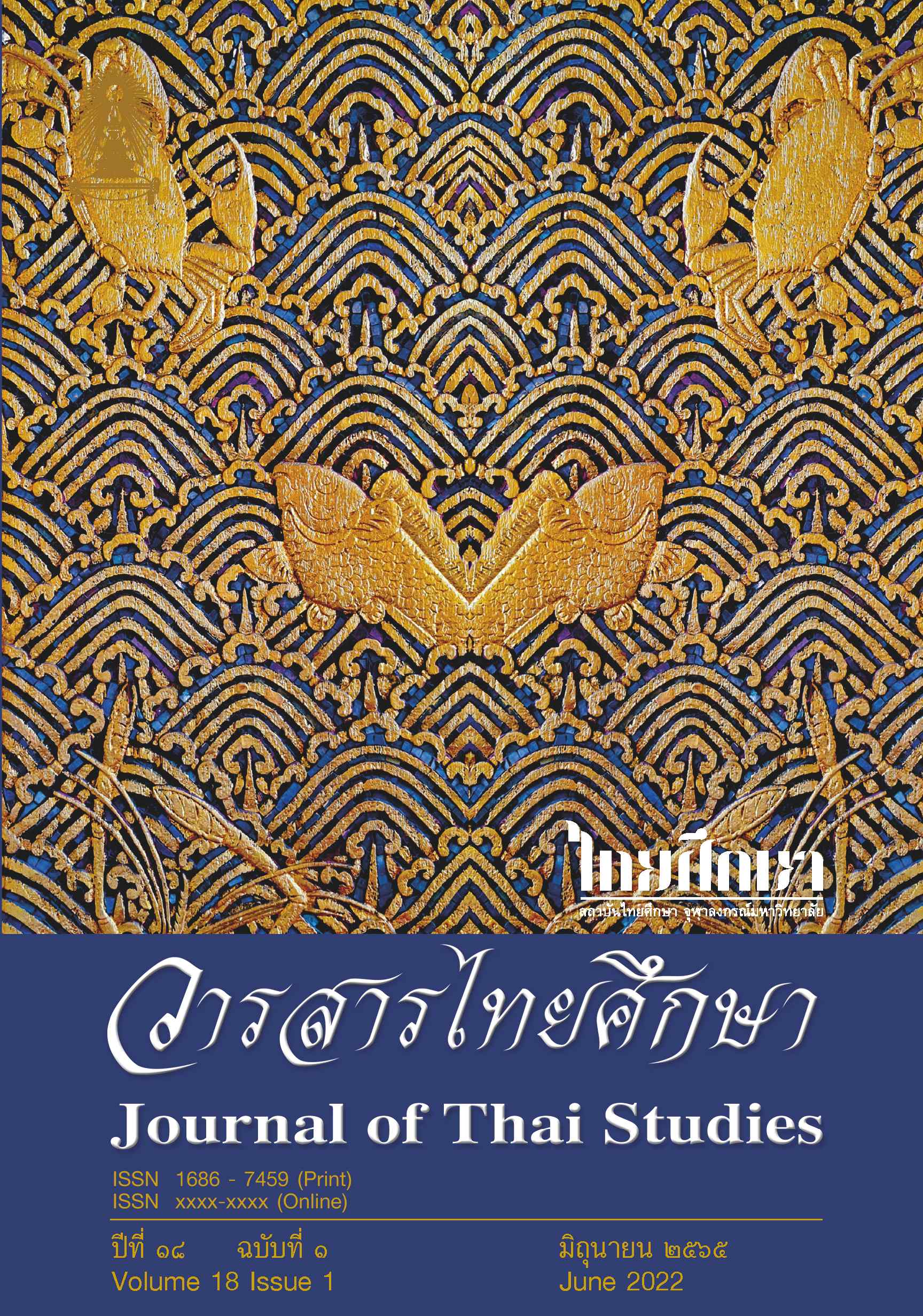
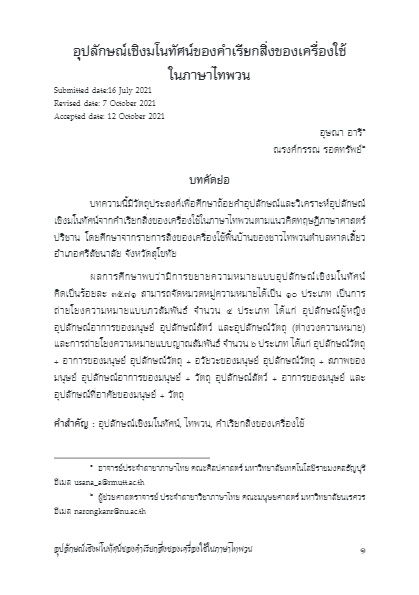
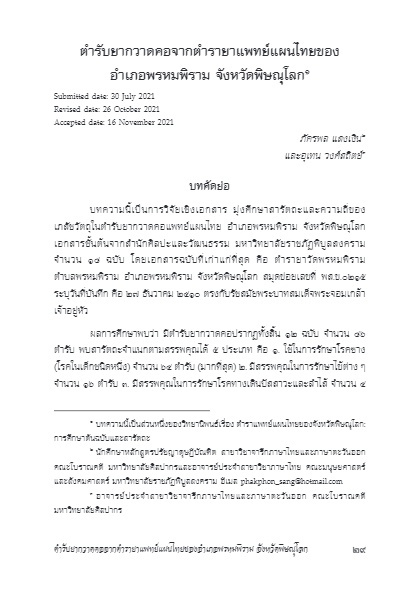
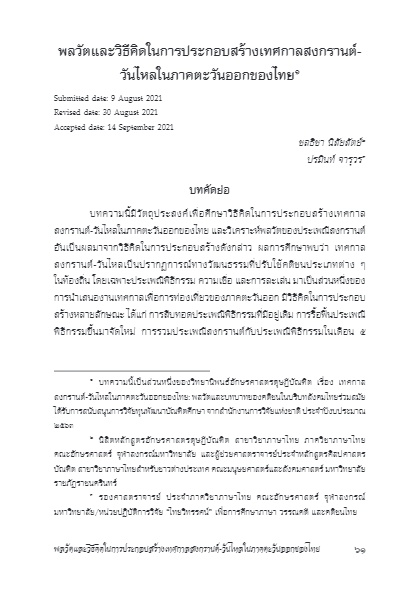
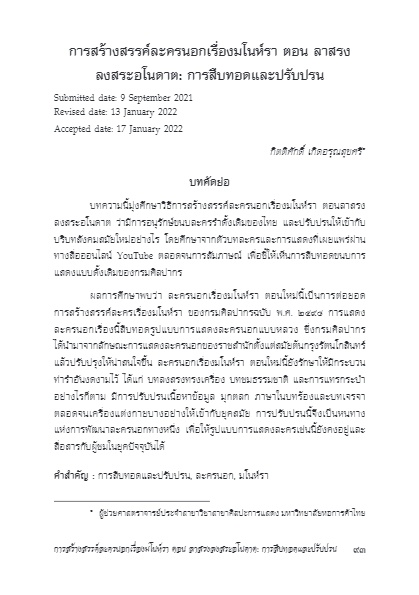
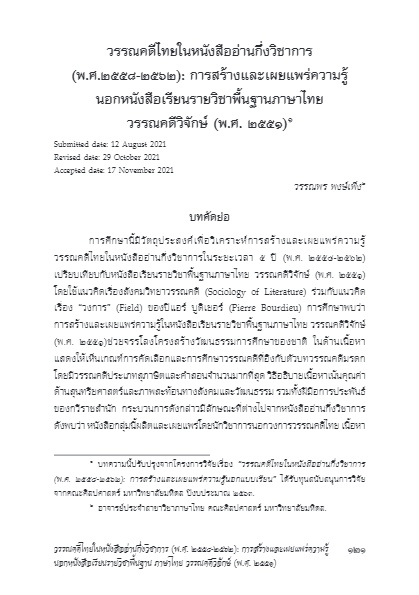
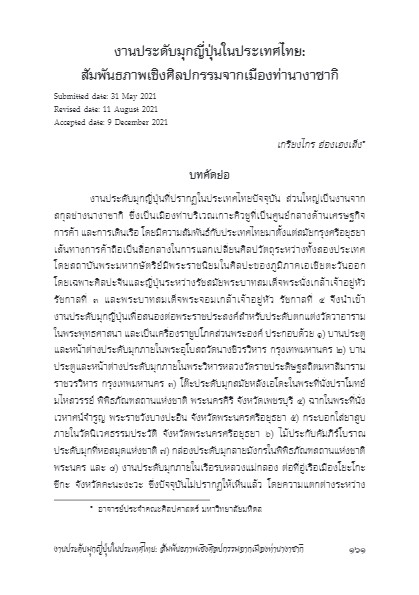
.pdf.jpg?alt=media&token=f690e5b9-06ba-4e0f-a85a-dc9cc4fd00a8)